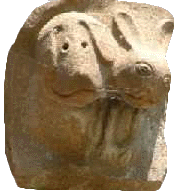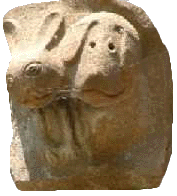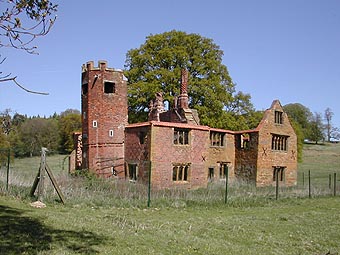 ..............The Archaeology Of Hunting...........
..............The Archaeology Of Hunting...........
Sculpture from Kilpeck Church
 ..............The Archaeology Of Hunting...........
..............The Archaeology Of Hunting...........
As hunting was a key element in the economy of early societies it is hardly surprising that it has left its traces in the historic fabric of the countryside nor should it surprise us that hunting and the monuments it has left behind have much more to do with survival and economic necessity than sport. The main function of the sites we are going to be consider was to enable the huntsman to work efficiently and effectively, we will see the evidence of the time and trouble that was taken to manage deer, rabbits and wild fowl to bring returns which were not really very ‘sporting’ at all.
Deer Parks...................................................................
The earliest and most accessible monuments to hunting in this country are the many medieval deer parks which survive: some well known and still fulfilling their original function, others lost: absorbed into later landscaped parks or surviving completely unrecognized as patches of woodland or in the pattern of field boundaries. The arrival of the Normans signaled a more centralized approach to government with royalty acquiring new dignities and privileges. one of these was manifest in the setting aside of large tracts of country as royal hunting preserves or forests. These were distinguished by their legal status rather than any physical barrier. However such forests were not easy to manage. the grazing of livestock under commoners rights gradually turned woodland to wooded pasture but continual grazing eventually reduced the land to open common which was no longer well suited to the needs of the chase. Towards the end of the twelfth century it became clear that deer as a resource needed more careful management thus the creation of the first parks.
Park pale, west side of Badby Deer Park SP 558582
These tended to be on the forest margins and differed in that they were enclosed, sometimes by a wall alone but more usually by a massive earthwork, the park pale. As deer can jump up to six metres horizontally and three metres vertically this had to be a formidable barrier. The usual form was of a large bank, three to four metres high topped by a strong wooden fence. On the inside, to deny the deer the footing to take off, would be a steep sided ditch of similar dimensions to the bank. Although many of these earthworks have been lost to the plough enough survive around the country, allbeit in a degraded state, to reveal how widespread a feature deer parks became. Indeed by the start of the fourteenth century there were something like 3,200 deer parks in England occupying around 260,000 hectares (650,000 acres) which represented something like 2% of the countryside. Typically the area enclosed was between 60 and 120 hectares (150 - 300 acres) and generally rounded in plan so as to enclose the maximum area with the minimum investment in time and resources for digging ditches and erecting fencing. One curious feature which careful observers may be able to trace on the ground was the presence of deer leaps. These were entrances into the park fronted by a fence or ramp and backed by a considerable drop on the other side, which acted as one way valves allowing truly wild deer access to the park to generally increase and improve the stock held.
Once introduced by the monarchy the passion for parks soon spread to the great figures of state and then to the lesser nobility. It was necessary to obtain a licence to create a new park but during the period of strong economic growth through the thirteenth century there was no shortage of applicants. There was certainly an element of demonstrating one’s status and wealth but the main pressure behind the development of deer parks was economic. Although some landowners maintained their parks as examples of ‘conspicuous consumption’ and did not expect a huge return from what was often marginal land other, perhaps better managed estates ran their deer on an industrial scale.
The deer park at Woodstock in Oxfordshire was home to between two and three thousand deer and although hunting was an occasional event as in 1303 when Edward Balliol is recorded as taking one ‘for sport’ the more usual mode of operation for the park is seen in the winter of 1250 when 200 does were ordered to be killed and salted down, half the quantity being sent to Winchester for the Christmas festivities and the rest to Westminster for the feast of St. Edward.
The deer were sometimes fed hay to help them over winter and larger parks were able to help smaller parks with restocking. All this demanded a resident staff and most parks had a hunting lodge which doubled as accommodation for the visiting nobility and the centre for the day to day running of the park . Few of these survive as standing buildings but as many were enclosed by small water filled moats their sites can often be traced on the ground

Sixteenth century and later hunting lodge, Badby SP570579
Minor Royal Hunting Lodge. layout based on excavated remains, Writtle, Essex
Deer parks had other economic functions: livestock was grazed under more carefully controlled conditions, the timber was managed with some areas being coppiced, this meant that within the park pale there would sometimes be further banks and ditches so that certain areas of the park could be denied to the deer as when new shoots were developing from coppiced stools. Streams within the park would be dammed to create ponds for fish and wild fowl and rabbits would be farmed by building artificial warrens. These have all left traces on the ground indeed both medieval fishponds and rabbit warrens are wide spread and often found in other contexts. The economics supporting the medieval deer park collapsed in the late medieval period as the feudal system broke down. Although some were retained in their original setting to be converted into an attractive landscape for gracious living many more were absorbed back into the fabric of the countryside some returning to woodland whilst others were completely cleared and given over to farming.
............................
Rabbit Warrens.
The rabbit was also introduced into England, probably from Iberia, by the Normans for their fur and meat. Originally rather delicate creatures in order to thrive they had to be sheltered from the elements, protected from predators and fed regularly. To facilitate this artificial warrens were built consisting of low flat topped mounds, 10 to 20 metres long, 5 to 10 metres wide and up to a metre high sometimes surrounded by a shallow ditch. Such mounds are often called pillow mounds although on Dartmoor they are known as buries and historically were termed coney garths ( or sometimes conegar or coneygree). As they are not particularly striking monuments they are often overlooked, there are at least twelve in Blenheim Park but few visitors take note of them. It has been estimated that there are around 2,000 surviving in England most of them post medieval in date. One early example has been excavated in south Wales and dated to the late fourteenth century. Here artificial runs had been laid within the mound and covered with stone slabs. Warrens sometimes of considerable size existed on Dartmoor and around Thetford into the early twentieth century. Such large establishments boasted extensive banks to enclose the warrens and other features including vermin traps and pitfalls for catching the rabbits. Sometimes there were ranges of buildings for the warrener, his staff and their equipment. The tower at Thetford Warren is a well known example maintained by English Heritage
..........................................Duck Ponds..
Hunting wild fowl with birds of prey had been the prerogative of the nobility but there was also a regular trade for birds caught in net and snares. To promote this it was in everybody's interests to provide suitable habitats for wild fowl which would encourage them to take up residence and breed. As fish was such an important part of the medieval diet carefully managed fish ponds were abundant, some of them extraordinarily complex suggesting considerable levels of labour and expertise in their operation. The simplest provision that could be made for wild fowl was to create a small island to give breeding birds sanctuary. Many of these can still be seen as curious little mounds rising from the flat bottoms of embanked enclosures marking the site of drained ponds. Occasionally more elaborate arrangements of banks indicate a larger scale and more systematic approach to breeding ducks for the table. Ducks were trapped, sometimes in huge numbers by being driven into tunnel like nets. The technique was very labour intensive and was eventually abandoned in favour of the more sophisticated stratagem of luring water fowl into traps. The basic arrangement consisted of a large pond with a number of curving channels, called pipes radiating from the corners. These pipes were netted and diminished in size towards their extremities. The birds were actually lured along the pipes by a small dog which they, taking it to be a predator, sought to drive away. The first appearance of this method and the necessary structures to support it was around the middle of the seventeenth century. Duck decoys became a especially common in the fens following their drainage later on that century. By 1800 there were about 200 in operation around the country but that had diminished to 47 by 1886, 28 by 1918 and today just three can be seen in anything like their original state. There must be quite a number of curiously shaped overgrown or silted up ponds surviving as evidence of what was once a thriving trade.
The remains of park boundaries and associated earthworks, pillow mounds, fishponds and duck decoys testify to the need over the centuries to maximize the return on valuable resources of livestock which while not entirely domesticated was carefully managed to ensure the minimum necessary effort in the taking. The need for profitability drove the medieval landowner every bit as hard as it drives his modern counterpart.